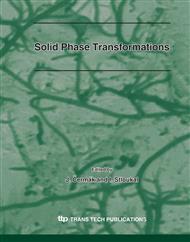p.347
p.355
p.367
p.377
p.385
p.393
p.399
p.407
p.451
Martensitic Transformation Behavior and Shape Memory Effect of an Aged Ni-rich Ti-Ni-Hf High Temperature Shape Memory Alloy
Abstract:
The martensitic transformation behavior and shape memory effect (SME) have been investigated in a Ni-rich Ti29.6Ni50.4Hf20 high temperature shape memory alloy (SMA) in the present study. After aging, the transformation temperatures of Ti29.6Ni50.4Hf20 alloy increase obviously due to the precipitation of (Ti,Hf)3Ni4 particles. And the transformation sequence changes from one-step to two-step. When the experimental alloy is aged at different temperatures for 2h, the transformation temperatures increase rapidly with increasing the aging temperature and then change slightly with further increasing the aging temperature. Most of the martensite variants preferentially oriented in the aged Ti29.6Ni50.4Hf20 alloy. The aged Ti29.6Ni50.4Hf20 alloy shows the better thermal stability of transformation temperatures than the solution-treated one because the precipitates depress the introduction of defects during thermal cycling. In addition, the proper aged Ti29.6Ni50.4Hf20 alloy also shows the larger SME than the solution-treated one since the precipitates strengthen the matrix strongly.
Info:
Periodical:
Pages:
399-406
Citation:
Online since:
March 2008
Authors:
Price:
Сopyright:
© 2008 Trans Tech Publications Ltd. All Rights Reserved
Share:
Citation:


